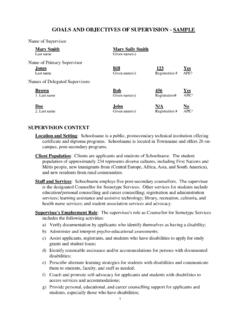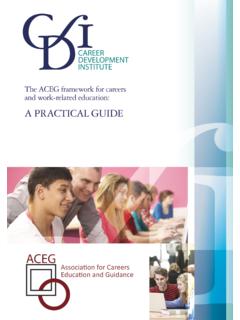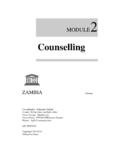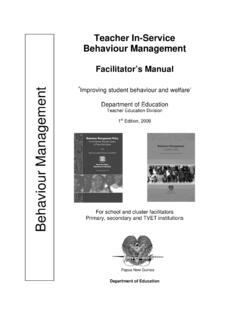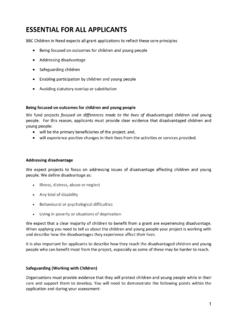Transcription of Breaking No. 14 practice briefing Policy and - …
1 Breaking down barriers to learning: primary school-based counselling and supportBy Mary Anne Webb, Dave Stewart and Dr Lisa Bunting with Hassan ReganJanuary 2012 Policy and practice briefingNo. 14 It is about reducing and removing barriers to learning, whatever those barriers may there can be a myriad of reasons why children would have a barrier to learning. (Teacher)IntroductionEducation provides children with vital life skills and can help combat future unemployment and social disadvantage. Many children are not achieving in school1, often coping with a chaotic family life, poverty, mental ill health and emotional problems.
2 This presents a challenge for schools which cannot always provide the requisite s NI supports many children and young people experiencing barriers to participation in education. Our range of evidence-based education work includes family support, coordinating extended schools clusters, restorative practices , social and emotional skills development, and school-based counselling . We believe resources should be more focused in schools while children are young to help them achieve their full potential. At a time of significant cuts in public sector funding, greater priority should be given to targeted early intervention programmes to prevent more costly interventions being needed later.
3 About this briefingRates of childhood depression or anxiety have doubled in the UK between 1988 and 2006 (Collishaw et al, 2010). One in ten UK children aged 5-16 years have been shown to experience a clinically diagnosable mental disorder (Green et al, 2005) which is around three children in every class. Only a minority of children experiencing mental health difficulties are referred to specialist mental health services (Ford et al, 2007; DHSSPS, 2006). Pressure on both children s social services and child and adolescent mental health services (CAMHS), together with growing recognition of the importance of early intervention (Allen, 2011a; 2011b), has led UK Policy makers to explore how best to improve children s mental health and emotional well-being outside clinical paper outlines the benefits of school-based counselling in improving emotional well-being and subsequent learning potential.
4 It also presents the key findings of an independent analysis of Barnardo s NI Time 4 Me primary school-based counselling service (Cooper et al, 2011, in preparation).Child mental health and emotional well-being Parental unemployment, lower family income, low parental educational attainment and family breakdown are associated with higher rates of mental disorders amongst children (Green et al, 2005). In Northern Ireland it is estimated that more than 20 per cent of young people are suffering significant mental health problems by their 18th birthday (Chief Medical Officer, 1999) and that they have, on average, experienced twice the number of negative life events and report much higher stress scores than adolescents in other countries (Royal College of Psychiatrists, 2006).
5 High rates of mental health difficulties in Northern Ireland are attributed to higher levels of deprivation than other parts of the UK coupled with thirty years of civil conflict (DHSSPS, 2006).A young person s mental health problems can impact on their family, educational and social life (Cooper et al, 2006; Fox and Butler, 2007) and greatly persist into adult life (Rutter et al, 2006). Long-term adverse outcomes include continuing mental health difficulties, poor educational performance, unemployment, low earnings, teenage parenthood, marital problems and criminal activity (Richards and Abbot, 2009).
6 The cost to society of a young person with a diagnosed psychiatric condition (conduct disorder) is estimated to be around 52,000 by the age of twenty-five (Barclays Wealth/New Philanthropy Capital (NPC), 2011).2 Emotional well-being is an important foundation for learning and educational achievement. There is a fundamental inverse relationship between high emotional arousal and thinking-learning capacity (Goleman, 1996). Research in the field of emotional intelligence demonstrates that a person s ability to perceive, identify and manage emotion is the basis for being successful (Cherniss, 2000).
7 This develops early in life and affects how productive children are in school (Goleman, 1996).1 For example, one in five children in Northern Ireland leaves primary school with literacy and numeracy problems (Education and Training Inspectorate (ETI) (2010) Chief Inspector s Report 2008 2010, ETI)2 Based on NPC calculations using figures from The Place2Be (2010) Cost-effective positive outcomes for children and families: An economic analysis of The Place2Be s integrated school-based services. London: Place2 BeBreaking down barriers to learningNo. 14 Policy and practice briefingWhat works?
8 A growing body of evidence points to the efficacy of therapeutic approaches to address children s various mental health difficulties. Carr s (2000; 2009) systematic reviews support the effectiveness of family therapy and systemic interventions for conduct disorders, emotional problems and eating disorders. Evidence from randomised controlled trials across a range of clinical settings also indicates that counselling interventions can be effective with children experiencing mild to moderate depression (NICE, 2005).Schools are increasingly viewed as integral to providing an accessible, non-stigmatising environment in which to promote emotional wellbeing and support children experiencing emotional, psychological and behavioural difficulties (NIMHE/CSIP, 2005; Welsh Assembly, 2006; DENI, 2009).
9 School-based counsellingEvaluations of counselling services in UK secondary schools indicate it is an effective intervention (Adamson et al, 2006; Fox and Butler, 2007/2009; McKenzie et al, 2011). A systematic review of UK studies has shown post-primary counselling services are associated with large improvements in mental health, with approximately fifty per cent of clinically distressed young people demonstrating clinical improvement (Cooper, 2009). There was also evidence that counselling indirectly benefited the students capacities to study and learn.
10 A recent study using randomised controlled trial methodology found that young people allocated to counselling showed significantly greater improvements in well-being than those on a waiting list control (McArthur et al, 2011).Primary schoolsAlthough rates of mental disorders are lower amongst children aged 5-10 years compared to 11-15 year olds, eight per cent are still affected, particularly boys (Green et al, 2005)6. Across the UK counselling services are available in some primary schools, but there is no universal provision. While larger scale research is needed, small studies 3 Former Education Minister Catriona Ruane NI Assembly Press Release, 29/7/20094 Response to NI Assembly Question AQO 1336/11, 24/3/115 For information on PEHAW see: Among 5-10 year olds, ten per cent of boys and five per cent of girls have a mental disorder.













